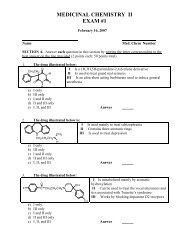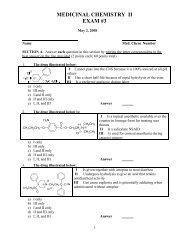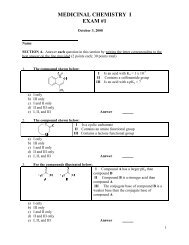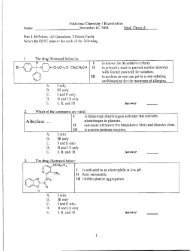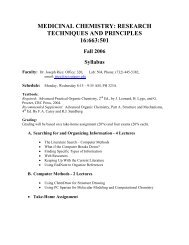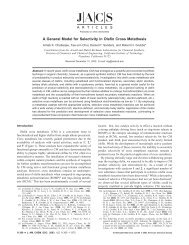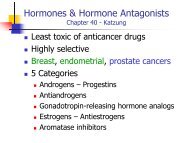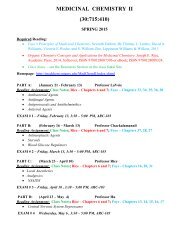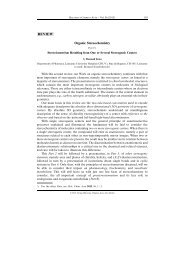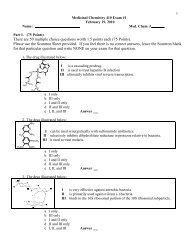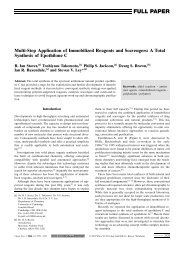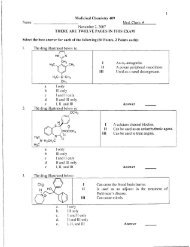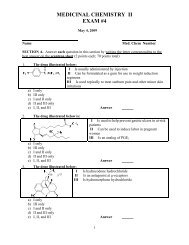Baldwin's Rules - Department of Medicinal Chemistry
Baldwin's Rules - Department of Medicinal Chemistry
Baldwin's Rules - Department of Medicinal Chemistry
Create successful ePaper yourself
Turn your PDF publications into a flip-book with our unique Google optimized e-Paper software.
Chemical Reviews REVIEW<br />
alkyne-iron complexes that may be an initial step in further<br />
chemical events.” 211<br />
Scheme 70. Prins-Type Closure <strong>of</strong> Terminal Alkynes<br />
The presence <strong>of</strong> the external nucleophile also plays a critical<br />
role in the cyclizations <strong>of</strong> these stabilized acyclic cations. Overman<br />
and Sharp examined the NPE cyclizations <strong>of</strong> a series <strong>of</strong> aza-<br />
Prins cyclizations, observing a lack <strong>of</strong> cyclic products in the<br />
absence <strong>of</strong> external nucleophile and chemoselective 6-exo closure<br />
onto an alkyne in the presence <strong>of</strong> a pendant alkene capable <strong>of</strong><br />
undergoing 5-exo-/6-endo-trig closure. While exocyclic closure is<br />
observed in the 6/7 pair for terminal and internal alkynes, electrophilic<br />
cyclization proceeded exclusively in a 6-endo-dig pathway<br />
upon exposure to either bromide or iodide (Scheme 71). 32,33<br />
Scheme 71. Nucleophile-Promoted Electrophilic Closures <strong>of</strong><br />
Iminium Ions with Alkynes in the Presence <strong>of</strong> Strong<br />
Nucleophiles a<br />
a HX = camphorsulfonic acid.<br />
Aside from facilitating the cyclization, the external nucleophile, as<br />
well as the Lewis acid, can modify or even control the regioselectivity<br />
<strong>of</strong> the cyclization. While the above FeCl3-induced closures were all<br />
endo selective, a mixture <strong>of</strong> products favoring 5-(π-vinylendo)-exodig<br />
closure is observed for SnBr 4 or BF 3 3 OEt 2. 110 Cho and coworkers<br />
have shown that, through two subtle modifications (a 2°<br />
benzylic homopropargylic alcohol as opposed to a 2° aliphatic<br />
and using TMSOTf as a Lewis acid) the regioselectivity can<br />
be completely tuned toward 5-(π-vinylendo)-exo-dig closure<br />
(Scheme 72). 212 A highly selective and efficient 5-exo-dig<br />
ring closure <strong>of</strong> a Ph-substituted alkyne, which may proceed<br />
through a similar oxocarbenium intermediate, is also known. 213<br />
NPEC can also occur between “two” triple bonds (CtC<br />
and NtN), as exemplified by the Richter reaction, 214 where<br />
cyclization between a vicinyl alkyne and diazonium salt is<br />
observed only in the presence <strong>of</strong> a suitable nucleophile (motif<br />
C, Scheme 73). Initial studies observed the formation <strong>of</strong> hydroxycinnoline<br />
derivatives, where simultaneous attack <strong>of</strong> a water<br />
molecule on the interior carbon <strong>of</strong> the alkyne and C Nbond<br />
formation was proposed. 215 Vasilevsky and Tretyakov found<br />
that nucleophilic attack by a less nucleophilic halogen anion<br />
can outcompete that <strong>of</strong> water at room temperature, giving<br />
halogenated 6,6 (cinnolines) and 5,6 (pyrazolopyridazines) 216<br />
Scheme 72. Effects <strong>of</strong> Lewis Acid/Nucleophile upon the<br />
Regioselectivity <strong>of</strong> Prins-Type Cyclizations <strong>of</strong> Homopropargylic<br />
Alcohols<br />
Scheme 73. In situ Formation <strong>of</strong> Diazonium Salt, Trapped by<br />
6-endo-dig Closure upon Intermolecular Attack <strong>of</strong> a Chlorine<br />
Anion<br />
in up to 53 and 93% yields for the chloro- and bromo-derivatives,<br />
respectively. 217<br />
The effect <strong>of</strong> temperature is also critical to the products obtained.<br />
When alkyne 3.433 istreatedwithHBr(aq) at 95 °C, exclusive<br />
formation <strong>of</strong> 6-endo-dig product 3.436 is observed; 218 however, at<br />
room temperature the major product was that <strong>of</strong> 5-exo-dig cyclization<br />
(3.435,Scheme74). 219<br />
Scheme 74. Effects <strong>of</strong> Temperature on Product Distribution <strong>of</strong><br />
the Richter Cyclization with (p-MeOC 6H 4)-Substituted Alkynes<br />
The nature <strong>of</strong> the cyclic core also has a significant influence on<br />
the regioselectivity <strong>of</strong> cyclization. The effects <strong>of</strong> temperature can<br />
be superseded by those <strong>of</strong> strain, as shown by Vasilevsky et al.,<br />
where no formation <strong>of</strong> the 5,5-bicyclic product was observed<br />
(Scheme 75). 216 When 2-acetylenic anthraquinone-1-diazonium<br />
salts are exposed to similar conditions at room temperature,<br />
AI dx.doi.org/10.1021/cr200164y |Chem. Rev. XXXX, XXX, 000–000



